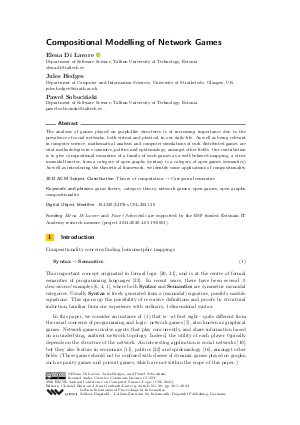Compositional Modelling of Network Games
Authors
Elena Di Lavore  ,
Jules Hedges,
Paweł Sobociński
,
Jules Hedges,
Paweł Sobociński
-
Part of:
Volume:
29th EACSL Annual Conference on Computer Science Logic (CSL 2021)
Part of: Series: Leibniz International Proceedings in Informatics (LIPIcs)
Part of: Conference: Computer Science Logic (CSL) - License:
 Creative Commons Attribution 3.0 Unported license
Creative Commons Attribution 3.0 Unported license
- Publication Date: 2021-01-13
File

PDF
LIPIcs.CSL.2021.30.pdf
- Filesize: 0.63 MB
- 24 pages
Document Identifiers
Subject Classification
ACM Subject Classification
- Theory of computation → Categorical semantics
Keywords
- game theory
- category theory
- network games
- open games
- open graphs
- compositionality
Metrics
- Access Statistics
-
Total Accesses (updated on a weekly basis)
0Document
0Metadata
Abstract
The analysis of games played on graph-like structures is of increasing importance due to the prevalence of social networks, both virtual and physical, in our daily life. As well as being relevant in computer science, mathematical analysis and computer simulations of such distributed games are vital methodologies in economics, politics and epidemiology, amongst other fields. Our contribution is to give compositional semantics of a family of such games as a well-behaved mapping, a strict monoidal functor, from a category of open graphs (syntax) to a category of open games (semantics). As well as introducing the theoretical framework, we identify some applications of compositionality.
Cite As Get BibTex
Elena Di Lavore, Jules Hedges, and Paweł Sobociński. Compositional Modelling of Network Games. In 29th EACSL Annual Conference on Computer Science Logic (CSL 2021). Leibniz International Proceedings in Informatics (LIPIcs), Volume 183, pp. 30:1-30:24, Schloss Dagstuhl – Leibniz-Zentrum für Informatik (2021)
https://doi.org/10.4230/LIPIcs.CSL.2021.30
BibTex
@InProceedings{dilavore_et_al:LIPIcs.CSL.2021.30,
author = {Di Lavore, Elena and Hedges, Jules and Soboci\'{n}ski, Pawe{\l}},
title = {{Compositional Modelling of Network Games}},
booktitle = {29th EACSL Annual Conference on Computer Science Logic (CSL 2021)},
pages = {30:1--30:24},
series = {Leibniz International Proceedings in Informatics (LIPIcs)},
ISBN = {978-3-95977-175-7},
ISSN = {1868-8969},
year = {2021},
volume = {183},
editor = {Baier, Christel and Goubault-Larrecq, Jean},
publisher = {Schloss Dagstuhl -- Leibniz-Zentrum f{\"u}r Informatik},
address = {Dagstuhl, Germany},
URL = {https://drops.dagstuhl.de/entities/document/10.4230/LIPIcs.CSL.2021.30},
URN = {urn:nbn:de:0030-drops-134645},
doi = {10.4230/LIPIcs.CSL.2021.30},
annote = {Keywords: game theory, category theory, network games, open games, open graphs, compositionality}
}
Author Details
- Department of Computer and Information Sciences, University of Strathclyde, Glasgow, UK
Funding
Elena Di Lavore and Paweł Sobociński are supported by the ESF funded Estonian IT Academy research measure (project 2014-2020.4.05.19-0001).
References
- John C Baez and Brendan Fong. A compositional framework for passive linear networks, 2015. arXiv preprint: URL: https://arxiv.org/abs/1504.05625.
- Joe Bolt, Jules Hedges, and Philipp Zahn. Bayesian open games, 2019. arXiv preprint: URL: https://arxiv.org/abs/1910.03656.
- Filippo Bonchi, Fabio Gadducci, Aleks Kissinger, Pawel Sobocinski, and Fabio Zanasi. Rewriting modulo symmetric monoidal structure. In Martin Grohe, Eric Koskinen, and Natarajan Shankar, editors, Proceedings of the 31st Annual ACM/IEEE Symposium on Logic in Computer Science, LICS '16, New York, NY, USA, July 5-8, 2016, pages 710-719. ACM, 2016. URL: https://doi.org/10.1145/2933575.2935316.
- Filippo Bonchi, Pawel Sobocinski, and Fabio Zanasi. The calculus of signal flow diagrams I: linear relations on streams. Inf. Comput., 252:2-29, 2017. URL: https://doi.org/10.1016/j.ic.2016.03.002.
-
Yann Bramoullé, Andrea Galeotti, and Brian Rogers. The Oxford handbook of the economics of networks. Oxford University Press, 2016.

- Roberto Bruni, Hernán C. Melgratti, and Ugo Montanari. A connector algebra for P/T nets interactions. In Concurrency Theory (CONCUR `11), volume 6901 of LNCS, pages 312-326. Springer, 2011. URL: https://doi.org/10.1007/978-3-642-23217-6_21.
- Apiwat Chantawibul and Paweł Sobociński. Towards compositional graph theory. In Proceedings of MFPS'15, volume 319 of ENTCS, pages 121-136, 2015. URL: https://doi.org/10.1016/j.entcs.2015.12.009.
-
J. R. B. Cockett and R. A. G. Seely. Linearly distributive functors. Journal of Pure and Applied Algebra, 143(1-3):155-203, 1999.

-
Brendan Fong. Decorated cospans. Theory and Applications of Categories, 30(33):1096-1120, 2015.

- James H Fowler and Nicholas A Christakis. Dynamic spread of happiness in a large social network: longitudinal analysis over 20 years in the framingham heart study. BMJ, 337, 2008. URL: https://doi.org/10.1136/bmj.a2338.
- Andrea Galeotti. Talking, searching and pricing. International Economic Review, 51(4):1159-1174, 2010. URL: https://doi.org/10.1111/j.1468-2354.2010.00614.x.
-
Andrea Galeotti, Benjamin Golub, and Sanjeev Goyal. Targeting interventions in networks. Forthcoming in Econometrica, 2019.

- Neil Ghani, Jules Hedges, Viktor Winschel, and Philipp Zahn. Compositional game theory. In Proceedings of Logic in Computer Science (LiCS) 2018. ACM, 2018. URL: https://doi.org/10.1145/3209108.3209165.
- Matthew Jackson and Yves Zenou. Games on networks. In Handbook of game theory with economic applications, volume 4, chapter 3, pages 95-163. Elsevier, 2015. URL: https://doi.org/10.1016/B978-0-444-53766-9.00003-3.
-
Stephen Lack. Composing PROPs. Theor. App. Categories, 13(9):147-163, 2004.

- Qiu Li, MingChu Li, Lin Lv, Cheng Guo, and Kun Lu. A new prediction model of infectious diseases with vaccination strategies based on evolutionary game theory. Chaos, Solitons & Fractals, 104:51-60, 2017. URL: https://doi.org/10.1016/j.chaos.2017.07.022.
-
Saunders Mac Lane. Categorical algebra. Bull. Amer. Math. Soc., 71:40-106, 1965.

-
Saunders Mac Lane. Categories for the Working Mathematician. Springer-Verlag New York, 1978.

-
Frank Joseph Oles. A Category-theoretic Approach to the Semantics of Programming Languages. PhD thesis, Syracuse University, Syracuse, NY, USA, 1982. AAI8301650.

-
Alfred Tarski. The concept of truth in the languages of the deductive sciences. Prace Towarzystwa Naukowego Warszawskiego, Wydzial III Nauk Matematyczno-Fizycznych, 34(13-172):198, 1933.

-
Alfred Tarski and Robert L Vaught. Arithmetical extensions of relational systems. Compositio mathematica, 13:81-102, 1957.

- Giorgio Topa. Social Interactions, Local Spillovers and Unemployment. The Review of Economic Studies, 68(2):261-295, April 2001. URL: https://doi.org/10.1111/1467-937X.00169.
-
Glynn Winskel. The formal semantics of programming languages: an introduction. MIT press, 1993.

-
Fabio Zanasi. Interacting Hopf Algebras: the theory of linear systems. PhD thesis, École Normale Supérieure, 2015.

